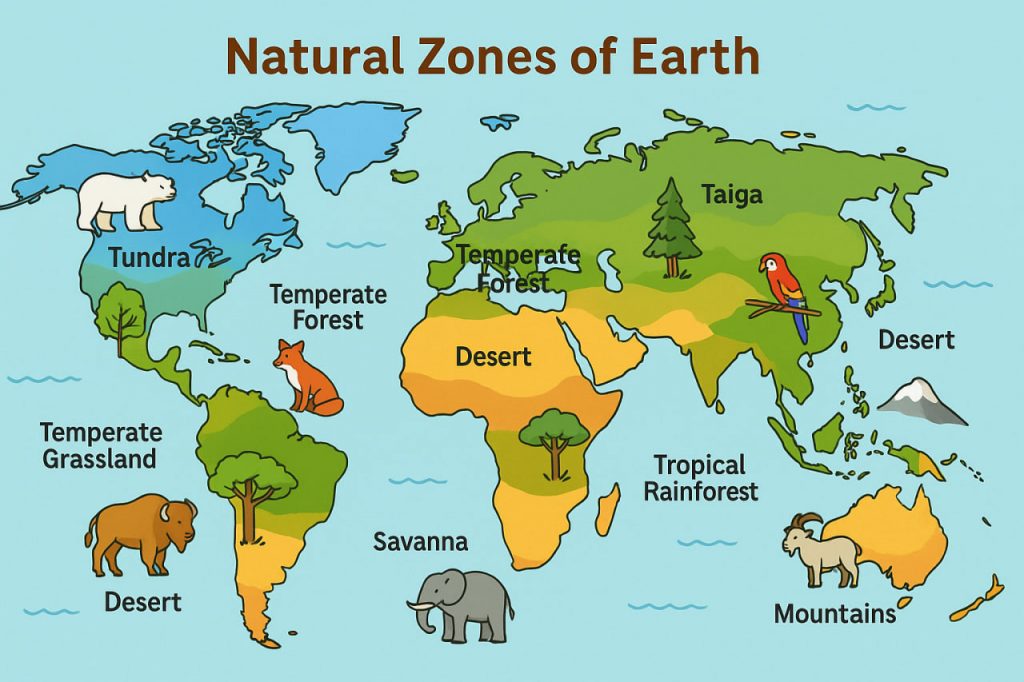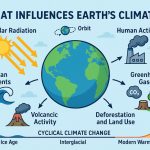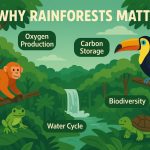Earth is home to an incredible variety of landscapes, climates, and life forms. These differences are organized into natural zones—large geographic areas with distinct climates, soil types, vegetation, and animal life. Studying these zones helps us understand how life adapts to different environments and how ecosystems function across the globe.
What Are Natural Zones?
A natural zone, also known as a biome, is a region where climate conditions determine the types of plants and animals that can live there. These zones often stretch across continents and are shaped primarily by:
- Temperature
- Precipitation
- Latitude and altitude
- Soil and terrain
Each zone supports a unique ecosystem, or community of living organisms interacting with their environment.
Major Natural Zones of Earth
1. Tropical Rainforest
- Location: Near the equator (Amazon, Congo, Southeast Asia)
- Climate: Hot and humid year-round
- Features: Dense vegetation, poor soil, high biodiversity
- Animals: Jaguars, toucans, monkeys, frogs
2. Savanna (Tropical Grasslands)
- Location: Africa, South America, Australia
- Climate: Warm with wet and dry seasons
- Features: Grasses with scattered trees
- Animals: Lions, elephants, zebras, antelopes
3. Desert
- Location: Africa (Sahara), Middle East, North America
- Climate: Very dry, often hot
- Features: Sand or rocky terrain, little vegetation
- Animals: Camels, lizards, scorpions, desert foxes
4. Temperate Forest
- Location: North America, Europe, East Asia
- Climate: Moderate temperatures, distinct seasons
- Features: Broadleaf trees (like oaks and maples), rich soil
- Animals: Deer, bears, foxes, birds
5. Steppe (Temperate Grasslands)
- Location: Central Asia, North America, Eastern Europe
- Climate: Hot summers, cold winters
- Features: Grasses dominate, few trees
- Animals: Bison, antelope, prairie dogs
6. Taiga (Boreal Forest)
- Location: Canada, Russia, Scandinavia
- Climate: Long, cold winters; short summers
- Features: Coniferous trees (pine, spruce), acidic soil
- Animals: Wolves, moose, lynx, owls
7. Tundra
- Location: Arctic regions, high mountains
- Climate: Very cold, little precipitation
- Features: Permafrost, low shrubs and moss
- Animals: Reindeer, Arctic foxes, polar bears
8. Mountains (Highlands)
- Location: Himalayas, Andes, Alps
- Climate: Varies with altitude
- Features: Rocky slopes, varied ecosystems depending on height
- Animals: Mountain goats, snow leopards, birds of prey
Why Natural Zones Matter
- Biodiversity: Each zone supports unique species adapted to its conditions.
- Climate Regulation: Forests, oceans, and wetlands help balance the global climate.
- Resources: Humans rely on different zones for food, water, medicine, and materials.
- Ecosystem Services: Natural zones provide air purification, water filtration, and soil fertility.
Human Impact on Natural Zones
Human activities such as deforestation, urbanization, pollution, and climate change are threatening the balance of many natural zones. For example:
- Rainforests are being cut down for agriculture.
- Deserts are expanding due to overgrazing and drought.
- Coral reefs (marine zones) are bleaching due to warming oceans.
Preserving natural zones is crucial for maintaining life on Earth.
Conclusion
Natural zones are the planet’s living geography. They illustrate how life thrives in every climate, from the humid jungles of the equator to the frozen tundra near the poles. Understanding and protecting these zones is essential for environmental sustainability, human health, and the future of biodiversity on Earth.
Glossary
- Biome: A large region characterized by specific climate, plants, and animals
- Ecosystem: A system formed by the interaction of living organisms with their environment
- Permafrost: Permanently frozen ground found in the Arctic tundra
- Biodiversity: The variety of life in a particular habitat or ecosystem
- Deforestation: The removal of large areas of forests


